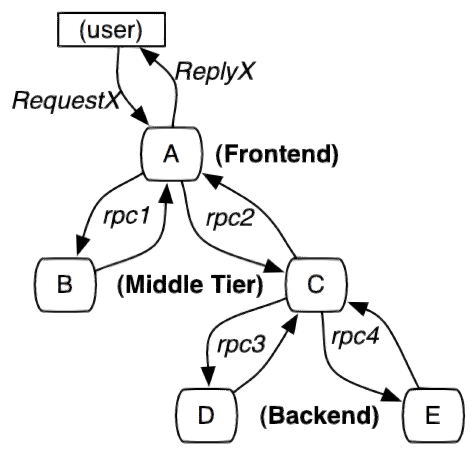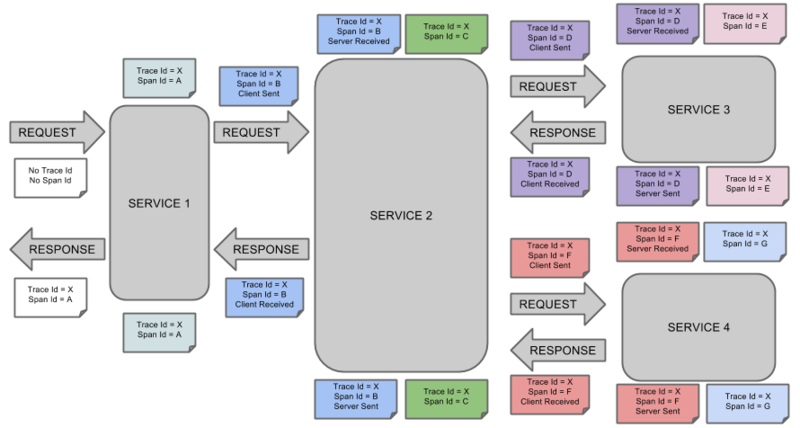
sc-sc - 云代码空间
——
这篇文章主要讲述服务追踪组件zipkin,Spring Cloud Sleuth集成了zipkin组件。
Add sleuth to the classpath of a Spring Boot application (see below for Maven and Gradle examples), and you will see the correlation data being collected in logs, as long as you are logging requests.
—— 摘自官网
Spring Cloud Sleuth 主要功能就是在分布式系统中提供追踪解决方案,并且兼容支持了 zipkin,你只需要在pom文件中引入相应的依赖即可。
微服务架构上通过业务来划分服务的,通过REST调用,对外暴露的一个接口,可能需要很多个服务协同才能完成这个接口功能,如果链路上任何一个服务出现问题或者网络超时,都会形成导致接口调用失败。随着业务的不断扩张,服务之间互相调用会越来越复杂。

将Span和Trace在一个系统中使用Zipkin注解的过程图形化:

基本知识讲解完毕,下面我们来实战,本文的案例主要有三个工程组成:一个server-zipkin,它的主要作用使用ZipkinServer 的功能,收集调用数据,并展示;一个service-hi,对外暴露hi接口;一个service-miya,对外暴露miya接口;这两个service可以相互调用;并且只有调用了,server-zipkin才会收集数据的,这就是为什么叫服务追踪了。
建一个spring-boot工程取名为server-zipkin,在其pom引入依赖:
<dependencies>
<dependency>
<groupId>org.springframework.boot</groupId>
<artifactId>spring-boot-starter</artifactId>
</dependency>
<dependency>
<groupId>org.springframework.boot</groupId>
<artifactId>spring-boot-starter-web</artifactId>
</dependency>
<dependency>
<groupId>org.springframework.boot</groupId>
<artifactId>spring-boot-starter-test</artifactId>
<scope>test</scope>
</dependency>
<dependency>
<groupId>io.zipkin.java</groupId>
<artifactId>zipkin-server</artifactId>
</dependency>
<dependency>
<groupId>io.zipkin.java</groupId>
<artifactId>zipkin-autoconfigure-ui</artifactId>
</dependency>
</dependencies>
<dependencyManagement>
<dependencies>
<dependency>
<groupId>org.springframework.cloud</groupId>
<artifactId>spring-cloud-dependencies</artifactId>
<version>Camden.SR6</version>
<type>pom</type>
<scope>import</scope>
</dependency>
</dependencies>
</dependencyManagement>
在其程序入口类, 加上注解@EnableZipkinServer,开启ZipkinServer的功能: @SpringBootApplication @EnableZipkinServer public class ServerZipkinApplication { public static void main(String[] args) {
SpringApplication.run(ServerZipkinApplication.class, args);
}
}
在配置文件application.yml指定服务端口为:
server.port=9411
在其pom引入起步依赖spring-cloud-starter-zipkin,代码如下:
<dependencies>
<dependency>
<groupId>org.springframework.boot</groupId>
<artifactId>spring-boot-starter-web</artifactId>
</dependency>
<!--compile('org.springframework.cloud:spring-cloud-starter-zipkin')-->
<dependency>
<groupId>org.springframework.cloud</groupId>
<artifactId>spring-cloud-starter-zipkin</artifactId>
</dependency>
<dependency>
<groupId>org.springframework.boot</groupId>
<artifactId>spring-boot-starter-test</artifactId>
<scope>test</scope>
</dependency>
</dependencies>
<dependencyManagement>
<dependencies>
<dependency>
<groupId>org.springframework.cloud</groupId>
<artifactId>spring-cloud-dependencies</artifactId>
<version>Dalston.RC1</version>
<type>pom</type>
<scope>import</scope>
</dependency>
</dependencies>
</dependencyManagement>
在其配置文件application.yml指定zipkin server的地址,头通过配置“spring.zipkin.base-url”指定:
server.port=8988 spring.zipkin.base-url=http://localhost:9411 spring.application.name=service-hi
通过引入spring-cloud-starter-zipkin依赖和设置spring.zipkin.base-url就可以了。
对外暴露接口:
@SpringBootApplication @RestController public class ServiceHiApplication { public static void main(String[] args) { SpringApplication.run(ServiceHiApplication.class, args); } private static final Logger LOG = Logger.getLogger(ServiceHiApplication.class.getName()); @Autowired private RestTemplate restTemplate; @Bean public RestTemplate getRestTemplate(){ return new RestTemplate(); } @RequestMapping("/hi") public String callHome(){ LOG.log(Level.INFO, "calling trace service-hi "); return restTemplate.getForObject("http://localhost:8989/miya", String.class); } @RequestMapping("/info") public String info(){ LOG.log(Level.INFO, "calling trace service-hi "); return "i'm service-hi"; } @Bean public AlwaysSampler defaultSampler(){ return new AlwaysSampler(); } }
Spring Cloud大型企业分布式微服务云架构源码请加企鹅求求:yuncode.net